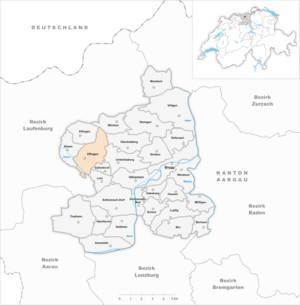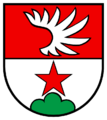Effingen facts for kids
Quick facts for kids
Effingen
|
||
|---|---|---|
 |
||
|
||
| Country | Switzerland | |
| Canton | Aargau | |
| District | Brugg | |
| Area | ||
| • Total | 6.85 km2 (2.64 sq mi) | |
| Elevation | 432 m (1,417 ft) | |
| Population
(December 2020)
|
||
| • Total | 632 | |
| • Density | 92.26/km2 (239.0/sq mi) | |
| Postal code |
5078
|
|
| Surrounded by | Bözen, Elfingen, Gallenkirch, Linn, Mönthal, Oberbözberg, Unterbözberg, Zeihen | |
Effingen was once a small town, or municipality, located in the Brugg district of the canton of Aargau in Switzerland. It was known for its beautiful natural surroundings.
On January 1, 2022, Effingen joined with three other nearby towns: Bözen, Elfingen, and Hornussen. Together, they formed a brand new, larger municipality called Böztal. This means Effingen is now part of a bigger community!
Contents
Effingen's Story: A Look at Its History
Effingen's history goes way back! The first time its name, Efingen, was written down was in 1284. But people lived here much earlier than that. Archeologists found signs of an old chapel and graves from the Alamanni people, who lived in the early Middle Ages.
How Effingen Was Governed Over Time
For a long time, Effingen was part of the Elfingen court system. Then, in 1460, a powerful city called Bern bought the area. Under Bern's rule, Effingen became part of the Bözen court, which was inside the Schenkenberg Bailiwick (a type of administrative area).
By the 1550s, the village started to have more control over its own rules. In 1614, the first village officials were mentioned, showing that local people were managing things.
Life in Effingen: From Farming to Modern Times
Effingen's chapel was connected to the Elfingen church, and later to the Bözen church after 1600. The village also had its own school by 1684, which was important for education.
For many years, farming was the main way people made a living in Effingen. Growing grapes for wine was especially important. In the 1700s, people also started processing cotton at home, which brought new jobs.
The village also had a tavern (like an inn or restaurant) since the 1200s. This was a popular stop for travelers crossing the Bözberg mountain, bringing more money to the village.
Connecting Effingen to the World
In the late 1700s, a new road was built, making it easier for people and goods to travel through Effingen. Then, in 1875, a railroad station was built, connecting the village to the wider world by train.
More recently, in 1996, the A3 motorway (a major highway) was built nearby. Since the 1980s, Effingen has grown with many new buildings. By 2000, most jobs in the village were in the "third sector," which means services like shops, offices, and tourism, rather than farming or manufacturing.
Effingen's Landscape: Where Is It?
Effingen covers an area of about 6.85 square kilometers (about 2.64 square miles). Imagine a square that's about 2.6 kilometers (1.6 miles) on each side – that's roughly the size of Effingen!
What the Land Is Used For
- Farmland: About 43.5% of Effingen's land is used for farming. This includes fields for crops and pastures where animals graze. Some areas also have orchards or vineyards.
- Forests: Nearly half of the land, about 47.2%, is covered by beautiful forests.
- Buildings and Roads: About 8.5% of the area is taken up by buildings, homes, and roads.
- Rivers and Lakes: A small part, about 0.7%, is made up of rivers and streams.
Effingen is located in the Brugg district, on the western side of the Bözberg mountain. It's mostly a "linear village," meaning its buildings are spread out along a road. It also includes a small hamlet called Chästel and a few scattered farmhouses.
How Far Is Effingen from Big Cities?
Even though Effingen is a smaller place, it's not too far from some of Switzerland's major cities:
- To Zürich: About 35 kilometers (22 miles)
- To Lucerne: About 52 kilometers (32 miles)
- To Bern: About 78 kilometers (48 miles)
Effingen's Coat of Arms
The blazon (official description) of Effingen's coat of arms is quite specific. It shows a red background with a silver wing on top. Below that, on a silver background, there's a red five-pointed star and green hills. This design represents the town's history and features.
Who Lives in Effingen? Demographics
Effingen has a population of about 600 people. As of June 2009, about 9.4% of the people living there were from other countries.
Languages Spoken
Most people in Effingen speak German, which is the main language in this part of Switzerland. About 93% of the population speaks German. Other languages spoken include Albanian and English.
Age Groups in Effingen
Here's a look at the different age groups in Effingen (as of 2008):
- Children (0-9 years old): About 7.2% of the population.
- Teenagers (10-19 years old): About 14.9% of the population.
- Young Adults (20-29 years old): About 14.5% of the population.
- Adults (30-59 years old): About 41.1% of the population.
- Seniors (60+ years old): About 18% of the population.
Homes and Education
Many homes in Effingen are owned by the people who live in them. In 2008, more than half of the homes were single-family houses.
Switzerland is known for its good education system. In Effingen, about 77.3% of adults (aged 25-64) have finished either high school or gone on to higher education, like a university or a specialized college. In the 2008/2009 school year, 35 students attended primary school in Effingen.
Population Changes Over Time
The number of people living in Effingen has changed over the years:
- 1764: 265 people
- 1850: 504 people
- 1900: 431 people
- 1950: 395 people
- 1980: 403 people
- 2000: 632 people
Transportation in Effingen
Effingen is located near the A3 motorway, which is a major highway in Switzerland. This makes it easy to travel by car to and from the village.
Effingen's Economy: How People Make a Living
In 2007, the unemployment rate in Effingen was quite low, at 1.53%. This means most people who wanted to work had jobs.
Types of Jobs
- Primary Sector: This includes jobs related to natural resources, like farming. In 2005, about 53 people worked in this sector.
- Secondary Sector: This involves manufacturing and construction. About 11 people worked in this sector.
- Tertiary Sector: This is the largest sector and includes service jobs, like working in shops, offices, or tourism. About 101 people worked in this sector.
Many people who live in Effingen travel to other towns for work. In 2000, about 71% of residents worked outside Effingen. For those who worked in Effingen, about 18.3% used public transportation, and 52% used a private car to get to their jobs.
Religion in Effingen
Based on the 2000 census, most people in Effingen belonged to one of two main Christian groups:
- Roman Catholic: About 26.9% of the population.
- Swiss Reformed Church: About 55.9% of the population.
Images for kids
See also
 In Spanish: Effingen para niños
In Spanish: Effingen para niños









